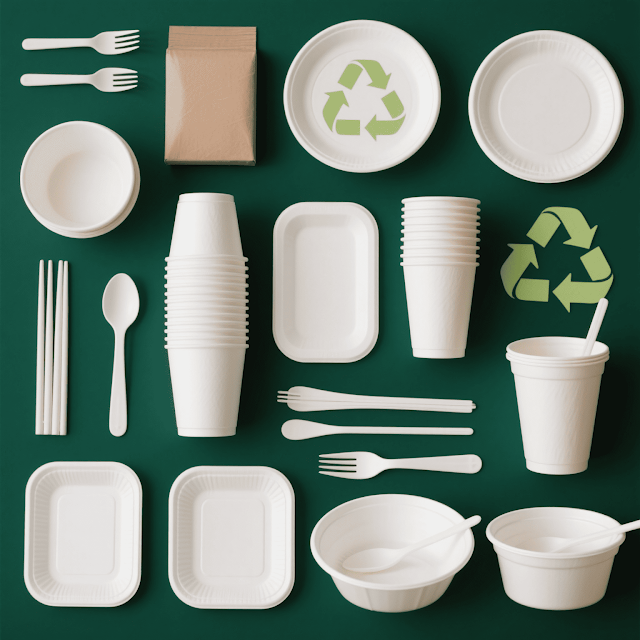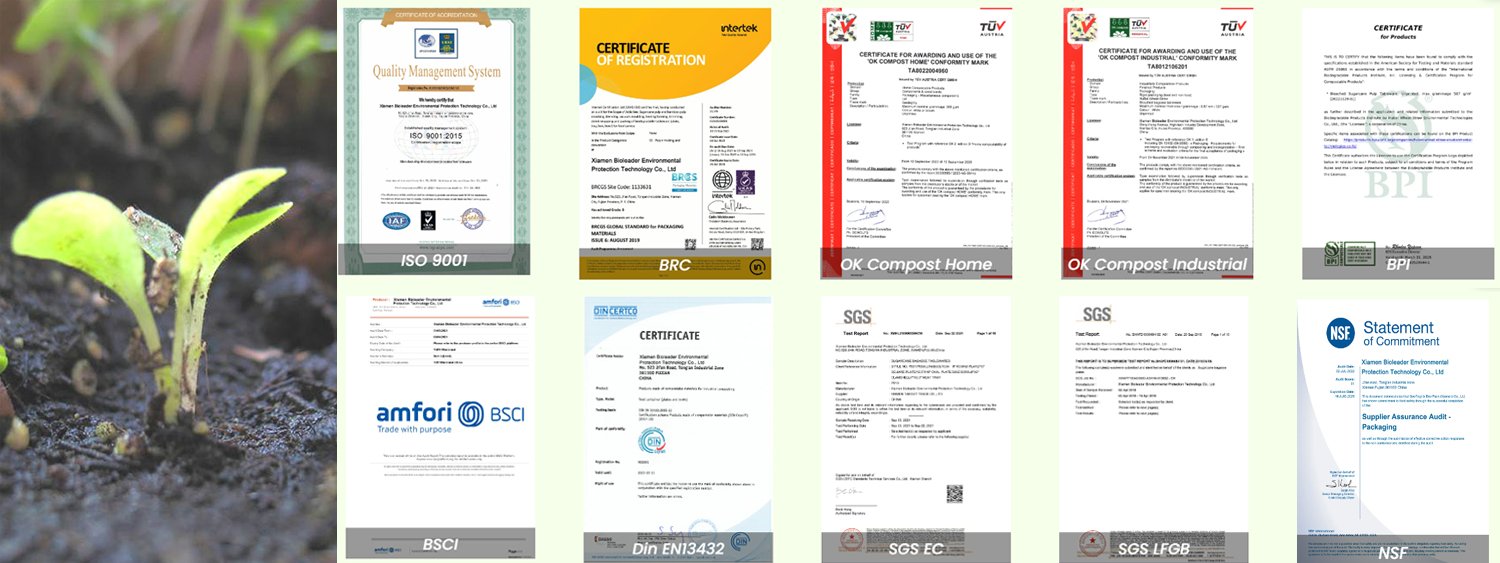1 Ton of Compostable Ware Saves 3 Tons of Waste
Introduction: The Hidden Weight of Disposable Tableware
Globally, foodservice and catering industries generate over 400 million tons of packaging waste annually, with disposable tableware accounting for a significant portion. According to the United Nations Environment Programme (UNEP), nearly 36% of all plastics produced are used in packaging, 85% of which ends up in landfills or as unregulated waste.
But there’s a breakthrough: switching to compostable tableware has been proven to reduce waste volume by up to 75%. And for every 1 ton of compostable alternatives used in place of traditional plastics or foam, up to 3 tons of solid waste are diverted from landfill or incineration.
This is not just a matter of “eco-friendliness”—it’s a systems-level shift toward a circular economy powered by renewable, compostable materials that restore rather than deplete.
What Is Compostable Tableware?
Compostable tableware refers to plates, cups, bowls, utensils, trays, and containers made from plant-based or renewable materials designed to decompose into organic matter under composting conditions. Unlike plastic, which can take up to 500 years to degrade, compostable products break down in 45 to 180 days, leaving behind no microplastics or toxic residue.
To qualify as compostable, products must meet standards such as:
-
EN 13432 (EU)
-
ASTM D6400 (USA)
-
OK Compost Industrial/Home (TÜV Austria)
-
BPI Certified Compostable
The Real Numbers: Why 1 Ton Can Prevent 3 Tons of Waste
A 2023 analysis from the Institute for Environmental Packaging Research (IEPR) shows that every ton of compostable packaging used:
-
Displaces up to 2 tons of plastic waste that would otherwise end up in landfills or oceans
-
Prevents an additional 1 ton of associated food waste, which is more easily composted alongside the tableware
-
Saves up to 4.2 tons of CO₂ emissions, largely from the reduction of incineration and plastic production
These findings underscore the cascading effect of switching from plastic to compostable packaging.
Breaking Down the Most Popular Compostable Materials
1. Sugarcane Bagasse
Source: The dry pulp leftover after sugarcane juice extraction
Compost Time: 60–90 days
Benefits:
-
Heat and oil resistant
-
Durable and microwave-safe
-
Compostable at home or in industrial facilities
Common Uses: Plates, bowls, clamshells, trays
Scientific Insight: A study in the Journal of Cleaner Production (2021) confirmed that bagasse-based plates produce 50–70% fewer greenhouse gas emissions compared to polystyrene.
2. PLA (Polylactic Acid) & CPLA
Source: Fermented cornstarch or sugarcane
PLA: Clear bioplastic, best for cold drinks and salad containers
CPLA: Crystallized version, suitable for hot items and cutlery
Compost Time: 90–180 days (requires industrial composting)
Key Traits:
-
Strong and lightweight
-
Customizable and moldable
-
Approved for food contact by FDA and EU standards
Note: PLA is not suitable for home composting environments due to temperature requirements.
3. Kraft Paper Tableware
Source: Wood pulp or recycled paper
Compost Time: 45–60 days (if uncoated or lined with PLA)
Strengths:
-
Lightweight and recyclable
-
Ideal for wraps, lunch boxes, trays
-
Great for branded packaging and printing
Tip: Look for bioplastic-lined kraft if water/oil resistance is needed.
4. Cornstarch-Based Packaging
Applications: Cutlery, containers, trays
Compost Time: 60–120 days
Benefits:
-
Biodegradable and renewable
-
Moldable into strong utensils and boxes
-
No petroleum base
Research Note: Cornstarch tableware degrade 4x faster than bioplastics under aerobic conditions, making them ideal for foodservice composting programs.
5. Bamboo and Palm Leaf
Breakdown Time: 60–90 days (home compostable)
Advantages:
-
Naturally antimicrobial
-
Beautiful texture and presentation
-
Heat-resistant and durable
Best Use: Eco-luxury catering and events
Environmental Impacts of Switching to Compostable Tableware
✅ 1. Reduced Landfill Mass
According to the EPA, food and packaging waste makes up nearly 45% of landfill volume. Compostable ware diverts this by:
-
Composting alongside food scraps
-
Eliminating long-term waste residue
-
Preventing methane emissions during decomposition
✅ 2. Cleaner Soil and Oceans
Plastic utensils and containers often escape waste management systems and contribute to microplastic pollution in soil and marine environments. Compostable alternatives fully break down without leaving residue.
✅ 3. Carbon Emission Reduction
A 2022 European Bioplastics Report found:
-
PLA emits 75% less CO₂ than PET
-
Bagasse products generate 60% lower cradle-to-grave emissions than foam or plastic equivalents
✅ 4. Supports Regenerative Agriculture
Post-consumer compost can be returned to farms, improving soil structure and water retention—creating a true circular loop between packaging and food production.
Case Example: Citywide Switch Cuts 500 Tons of Plastic Waste
In 2022, the city of San Francisco mandated compostable tableware for all public food vendors. Within 12 months:
-
Plastic plate waste dropped by 78%
-
Over 500 tons of food packaging were composted
-
The city’s organic waste facility reported a 34% increase in usable compost
-
Participating vendors reported improved customer satisfaction and footfall
How to Choose the Right Compostable Tableware
| Material | Home Compostable | Heat Resistant | Oil Resistant | Microwave Safe | Best Use |
|---|---|---|---|---|---|
| Bagasse | ✅ Yes | ✅ Yes | ✅ Yes | ✅ Yes | Takeout, hot meals |
| PLA | ❌ No | ❌ No | ✅ Yes | ❌ No | Cold drinks, salads |
| CPLA | ❌ No | ✅ Yes | ✅ Yes | ✅ Yes | Cutlery, hot lids |
| Kraft Paper | ✅ Yes (if unlined) | ❌ No | ❌ Limited | ❌ No | Food wraps, dry goods |
| Cornstarch | ✅ Yes | ✅ Moderate | ✅ Moderate | ✅ Yes | Utensils, clamshells |
| Bamboo | ✅ Yes | ✅ Yes | ✅ Yes | ✅ Yes | Premium plates, serving |
FAQ: Google’s Most Searched Questions on Compostable Tableware
1. What is the difference between compostable and biodegradable tableware?
Compostable products break down into non-toxic components under composting conditions. Biodegradable items break down over time but may leave residue and aren't always compost-safe.
2. Can compostable tableware go in the recycling bin?
No. Compostable items should be placed in organic waste bins or composted. They contaminate recycling streams.
3. How long does it take for compostable plates to degrade?
Depending on the material and composting environment, 45 to 180 days is typical.
4. Are compostable utensils heat-resistant?
Yes—CPLA, bagasse, bamboo, and cornstarch utensils are designed to handle hot food safely.
5. Where can I buy certified compostable tableware?
Certified manufacturers such as Xiamen Bioleader Environmental Protection Technology Co., Ltd. supply compostable tableware globally with bulk pricing and customization options.
Conclusion: Compostable Ware Is More Than a Trend—It’s a Transformation
Switching to compostable tableware is not just an environmental gesture—it’s a measurable, impactful solution. By replacing just 1 ton of plastic plates and utensils with compostable alternatives, businesses and institutions can eliminate up to 3 tons of total waste, reduce emissions, improve brand perception, and comply with tightening global regulations.
As the world faces a waste crisis, compostable solutions offer hope—and results. For restaurants, caterers, cities, and corporations alike, the path to a cleaner planet might just start with a single plate.




Comments